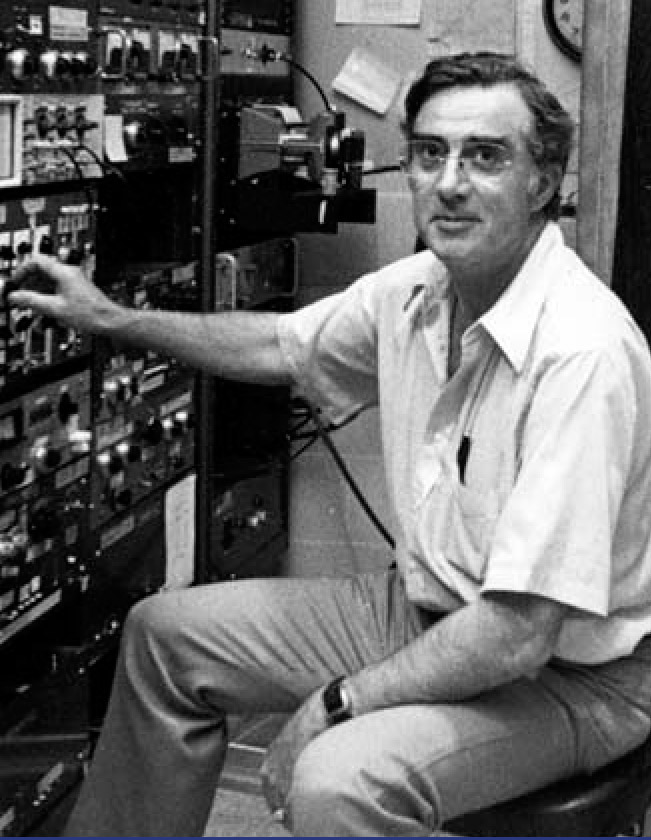Albert Victor Crewe
DOI: 10.1063/1.3502556
The remarkably productive life of physicist Albert Victor Crewe ended on 18 November 2009 in his home in Dune Acres, Indiana, when he lost his long struggle with Parkinson’s disease. Crewe’s invention of the scanning transmission electron microscope, or STEM, allowed scientists to resolve individual atoms.
Crewe was born in Bradford, UK, on 18 February 1927. He grew up during World War II in a blue-collar community. The first in his family to attend high school, he won a scholarship to the University of Liverpool, where he received a baccalaureate in physics. Because he had passed the scholarship examination with high honors, he was able to continue at the university as a graduate student. At the age of 24 he was hired by the university as an instructor. A year later, in 1951, he received a PhD in physics.
At Liverpool, Crewe worked under Herbert Skinner, head of a project to build a synchrocyclotron accelerator. Skinner gave Crewe the task of extracting the accelerated proton beam from the machine, a difficult feat of great potential value for the accelerators then coming into operation. Crewe demonstrated for the first time the successful operation of the regenerative (resonant) extraction system proposed earlier at the University of Chicago by James Tuck and one of us (Teng). In 1955 Crewe was invited to Chicago as a visiting research associate to extract the beam from Chicago’s newly commissioned synchrocyclotron. A year later, after successfully extracting the beam, he was appointed by the university as a tenure-track assistant professor.
At the time, Chicago scientists had a strong interest in the success of an accelerator project proposed by Argonne National Laboratory, and Crewe was among a group of university colleagues making frequent visits to Argonne to help with the design, especially with regard to the experimental areas.
In 1958 the Atomic Energy Commission approved the construction of the proposed 12.5-GeV Zero Gradient Synchrotron and Crewe’s appointment as director of Argonne’s particle accelerator division to head the ZGS project. During his tenure, Crewe contributed greatly to the eventual success of the project.
In 1961, when Argonne director Norman Hilberry retired, Crewe, then a 34-year-old associate professor, accepted an offer to become the third director of the 5000-employee facility. His task was made difficult by Midwest universities demanding that their own institutions have a part in setting policies for the laboratory. A management scheme intended to meet those demands was a tripartite contract for which in addition to the current operating contractor, the University of Chicago, policymaking and oversight authority for the lab’s high-energy physics operations was given to a third party, the Argonne Universities Association, newly formed by the Midwestern universities. But working within that contract, Crewe found it difficult to fix responsibilities, make workable plans, or escape endless, stressful meetings.
Nevertheless, the years of his administration were productive. For the first time, he pushed the basic research budget ahead of that for technical programs. In 1966, at the end of his five-year term, Crewe resigned as Argonne’s director and returned to his professorship at the University of Chicago.
Crewe’s major scientific achievement, taking almost four decades of effort, was to develop the STEM. The first requirement for his instrument was to produce a source of electrons, an “electron gun” with an effective size smaller than the desired resolution. To solve that problem, Crewe used field emission from the tip of a sharp needle.
The next requirement was to focus the electron beam to the same small source size onto an “image” plane, where it is used as a probe to scan across the sample. Given a sufficiently small source, the size of the image was determined by the magnitude of the spherical and chromatic aberrations in the focusing system. The solution to the problem of aberrations presented itself when Crewe gave a series of lectures on electron optics. One of his students pointed out at the end of the course that he had not mentioned sextupoles. Following up on the remark, Crewe wrote down the equations of motion and found that by incorporating two sextupoles, together with uniform magnetic and electrostatic fields, the aberrations could be eliminated.
The long effort to develop the electron gun and the much longer undertaking to produce an aberration-free focusing system resulted in a bright pointlike electron probe far superior to anything previously achieved. Crewe and his students applied the STEM to investigations in biology, metallurgy, and mineralogy, and in 1971 they used the STEM to produce images of single atoms. Thousands of STEMs are now in use at semiconductor fabrication facilities around the world.
Among his honors, Crewe received the 1976 Distinguished Physical Scientist award of the Microscopy Society of America, the 1977 Michelson Medal of the Franklin Institute, the 1979 Ernst Abbe Memorial Award of the New York Microscopical Society, and the 1980 Duddell Medal and Prize of the Institute of Physics. He was appointed to the University of Chicago’s William E. Wrather Distinguished Service Professorship in 1977.
Crewe’s outstanding contribution to science and his ever cheerful and optimistic disposition were deeply appreciated and will always be remembered by his colleagues and friends.

Albert Victor Crewe
UNIVERSITY OF CHICAGO NEWS OFFICE

More about the Authors
Lee C. Teng. 1 Argonne National Laboratory, Argonne, Illinois, US .
Roger H. Hildebrand. 2 University of Chicago, Chicago, Illinois, US .
